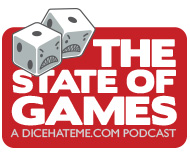The Crowded Table – Late Spring 2013 Edition
Hello, dear readers, and welcome to another installment of The Crowded Table. It’s been quite awhile since the last iteration of the Crowded Table, but still there have been plenty of interesting games to grace the gaming surfaces at Dice Hate Me HQ. Some of them have been mentioned a few times on The State of Games and The Geek All-Stars, but I felt the games below deserved a little more written attention. Some of them you may just see (or hear and see) more about in a future feature on Dice Hate Me! And away we go:
Coup
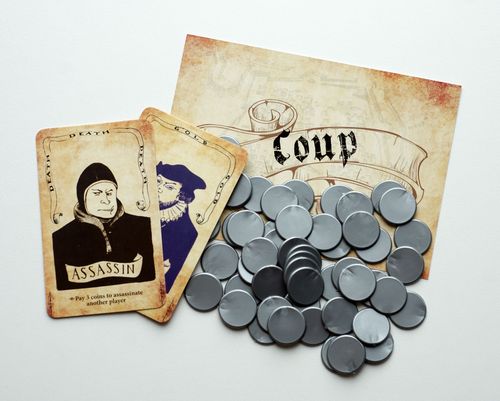 Dedicated readers and listeners will immediately know that I am a social gaming junkie. If there’s a system to be gamed by gaming the other gamers through sly promises and double-talking, I’m all in. Since you know that I know what I’m talking about I’m here to tell all of you, definitively, that Coup is one of the best social games I have played in several years. In Coup, each player controls two secret cards that could be one of several different types of characters – each with a special ability to cancel the powers of another character. Each round, players take turns announcing what character they are using and activating that ability. It doesn’t matter if the player has that character, it just matters if the other players believe that they do. Otherwise, any other player can call the alleged bluff and attempt to cancel the action with one of their face-down characters. Of course, if the calling player is wrong (or are themselves bluffing), there’s usually a steep price – and lots of cackling around the table. The winning player is the one left with any face-down characters in front of them. It’s a simple system that does what any great social game aims for: Steps back and graciously lets the players transform the game around them. The original Coup design has been scooped up by Indie Boards & Cards and is currently on Kickstarter with a retheme from The Resistance universe. The production and art is top-notch, but I tend to prefer the quirky original to this new Hunger Games-like rendition. Still, if you don’t have it, you need it – particularly if your idea of a good time is to watch everyone around the table sweat while you’re bluffing your butt off.
Dedicated readers and listeners will immediately know that I am a social gaming junkie. If there’s a system to be gamed by gaming the other gamers through sly promises and double-talking, I’m all in. Since you know that I know what I’m talking about I’m here to tell all of you, definitively, that Coup is one of the best social games I have played in several years. In Coup, each player controls two secret cards that could be one of several different types of characters – each with a special ability to cancel the powers of another character. Each round, players take turns announcing what character they are using and activating that ability. It doesn’t matter if the player has that character, it just matters if the other players believe that they do. Otherwise, any other player can call the alleged bluff and attempt to cancel the action with one of their face-down characters. Of course, if the calling player is wrong (or are themselves bluffing), there’s usually a steep price – and lots of cackling around the table. The winning player is the one left with any face-down characters in front of them. It’s a simple system that does what any great social game aims for: Steps back and graciously lets the players transform the game around them. The original Coup design has been scooped up by Indie Boards & Cards and is currently on Kickstarter with a retheme from The Resistance universe. The production and art is top-notch, but I tend to prefer the quirky original to this new Hunger Games-like rendition. Still, if you don’t have it, you need it – particularly if your idea of a good time is to watch everyone around the table sweat while you’re bluffing your butt off.
Manhattan Project
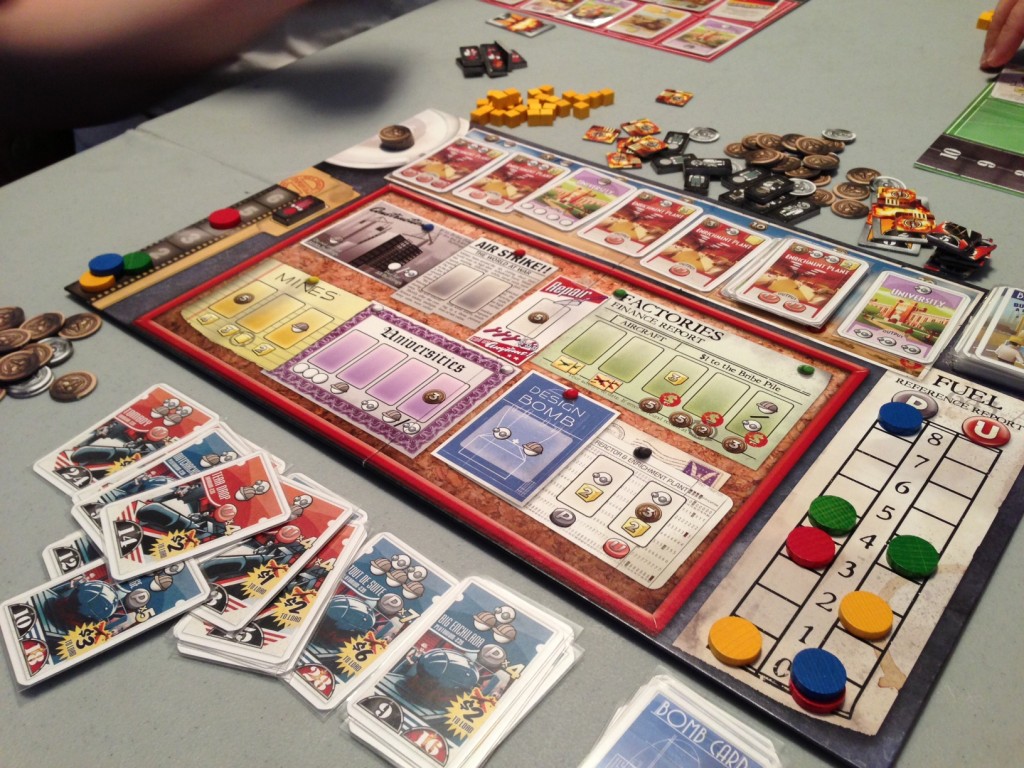 I may be a little slow on the take with this one since everyone and their brother has been raving about it since its release, but it was well worth the wait. This “worker takement” game with a unique theme is one of the best – and most atmospheric – Euros that I have experienced in recent years. In Manhattan Project, players take on the roles of different countries toward the end of WWII, all feverishly racing to develop the first atom bombs. As with most worker placement games, Manhattan Project has a slow burn at the start, but ramps up tremendously in the last few rounds, making many gamers break out in a cold sweat at the thought that they just might be one tiny step behind the leader. One advantage/drawback of Manhattan Project’s endgame is that it’s very sudden – once one player reaches the goal, the game ends immediately and there is no end score. After all, when someone achieves nuclear supremacy, it’s pretty much game over. Had I played Manhattan Project last year, it would have easily been in the running for my Game of the Year. Would it have beaten Fleet? Probably not, but it would have been a tight showing, and I would easily recommend the game to those who are looking for a solid, suspenseful addition to their stalwart worker placement library. I promise you that Manhattan Project promises to blow most worker placement games back to the Stone Age.
I may be a little slow on the take with this one since everyone and their brother has been raving about it since its release, but it was well worth the wait. This “worker takement” game with a unique theme is one of the best – and most atmospheric – Euros that I have experienced in recent years. In Manhattan Project, players take on the roles of different countries toward the end of WWII, all feverishly racing to develop the first atom bombs. As with most worker placement games, Manhattan Project has a slow burn at the start, but ramps up tremendously in the last few rounds, making many gamers break out in a cold sweat at the thought that they just might be one tiny step behind the leader. One advantage/drawback of Manhattan Project’s endgame is that it’s very sudden – once one player reaches the goal, the game ends immediately and there is no end score. After all, when someone achieves nuclear supremacy, it’s pretty much game over. Had I played Manhattan Project last year, it would have easily been in the running for my Game of the Year. Would it have beaten Fleet? Probably not, but it would have been a tight showing, and I would easily recommend the game to those who are looking for a solid, suspenseful addition to their stalwart worker placement library. I promise you that Manhattan Project promises to blow most worker placement games back to the Stone Age.
Glory to Rome
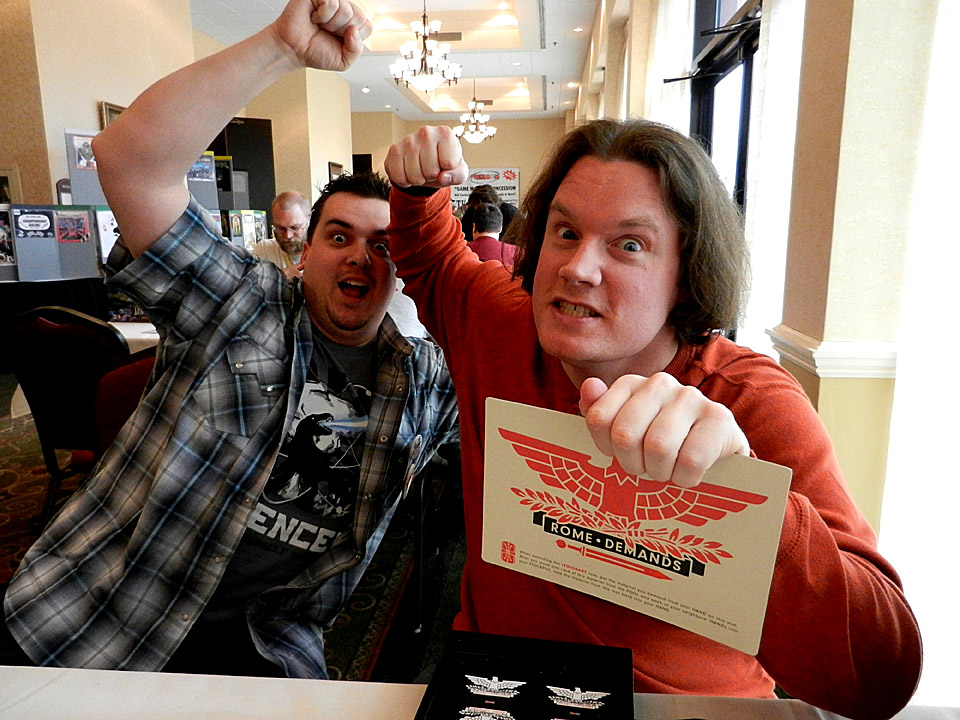 Continuing in the tradition of being behind the times in this Crowded Table, I finally got multiple chances to break out the Glory to Rome Black Box edition that I backed on Kickstarter eons ago. Again, it was well worth the wait. Never have I experienced a more madcap and yet satisfyingly-chaotic romp with random cards and rampant punk factor. For those not in the know, Glory to Rome centers on each player trying their darndest to build the greatest encampment/statuary/temple/monument to the great Roman throne in their personal real estate. They do this through the use of cards that can perform four different functions depending on when – and how – they are used in conjunction with other cards. It’s difficult to summarize the full extent of card play in Glory to Rome in a single paragraph, but if I was hard-pressed to express an analogy, it would be working toward the greatest single multiple-strike chaotic combo and Fatality string in Mortal Kombat history. With Cards. Glory to Rome is easily one of the best card games I’ve played in years and you’ll be hard pressed not to hear the chant “Finish Him” inside your head when you get that cardboard deathmobile purring.
Continuing in the tradition of being behind the times in this Crowded Table, I finally got multiple chances to break out the Glory to Rome Black Box edition that I backed on Kickstarter eons ago. Again, it was well worth the wait. Never have I experienced a more madcap and yet satisfyingly-chaotic romp with random cards and rampant punk factor. For those not in the know, Glory to Rome centers on each player trying their darndest to build the greatest encampment/statuary/temple/monument to the great Roman throne in their personal real estate. They do this through the use of cards that can perform four different functions depending on when – and how – they are used in conjunction with other cards. It’s difficult to summarize the full extent of card play in Glory to Rome in a single paragraph, but if I was hard-pressed to express an analogy, it would be working toward the greatest single multiple-strike chaotic combo and Fatality string in Mortal Kombat history. With Cards. Glory to Rome is easily one of the best card games I’ve played in years and you’ll be hard pressed not to hear the chant “Finish Him” inside your head when you get that cardboard deathmobile purring.
Keyflower
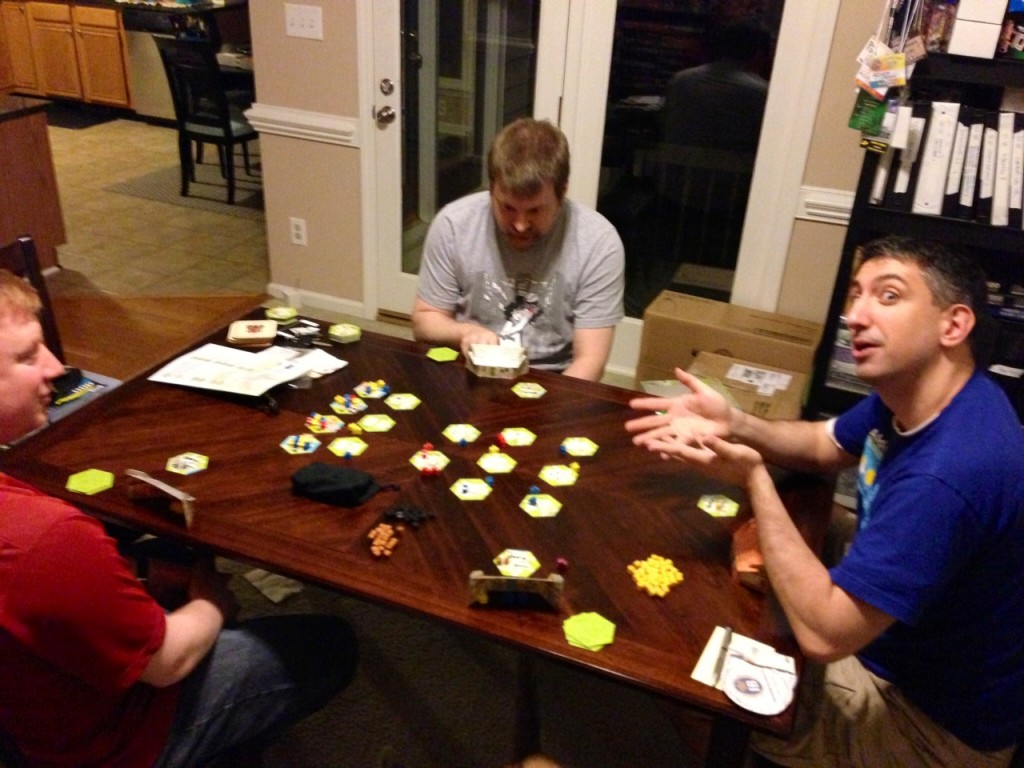 If I had to summarize Keyflower in a single word, it would be the word “unassuming.” From the packaging to the initial description, you don’t initially expect a whole lot from Keyflower. However, therein lies the strength of the design – once you play Keyflower, your expectations will be shattered in ways that just don’t happen with other games. At its core, Keyflower is a worker placement game. You have a ton of Meeples and you place those Meeples on your own turf – and others – to activate abilities that score you points. That’s all pretty familiar. What sets Keyflower apart is that you also have to decide when to use those same Meeples to bid on a select property instead of taking an action just so you can secure that action for future rounds (and points) in your settlement. Sometimes, that will result in you getting other Meeples back in another round for further placement, but quite often it means you’re sacrificing those Meeples to the stock, or other players. It’s this give and take of precious Meeple resources that really elevates Keyflower to another level of Euro – one in which I highly recommend for anyone who enjoys tossing little wooden people onto cardboard cutouts.
If I had to summarize Keyflower in a single word, it would be the word “unassuming.” From the packaging to the initial description, you don’t initially expect a whole lot from Keyflower. However, therein lies the strength of the design – once you play Keyflower, your expectations will be shattered in ways that just don’t happen with other games. At its core, Keyflower is a worker placement game. You have a ton of Meeples and you place those Meeples on your own turf – and others – to activate abilities that score you points. That’s all pretty familiar. What sets Keyflower apart is that you also have to decide when to use those same Meeples to bid on a select property instead of taking an action just so you can secure that action for future rounds (and points) in your settlement. Sometimes, that will result in you getting other Meeples back in another round for further placement, but quite often it means you’re sacrificing those Meeples to the stock, or other players. It’s this give and take of precious Meeple resources that really elevates Keyflower to another level of Euro – one in which I highly recommend for anyone who enjoys tossing little wooden people onto cardboard cutouts.
DC Deckbuilding Game
 With what could be the most boring game title of the past year or so, Cryptozoic has managed to create one of the most riveting card games in recent memory. Any dedicated reader of Dice Hate Me will know that I just don’t cotton to deckbuilders; I’d much rather poke my eyes out with sharp sticks than sit around and count how many actions I have left in a turn, or shuffle my deck for the umpteenth time. All that said, I will easily endorse the DC Deckbuilding Game as a Dice Hate Me Preferred Selection for 2013. Heck, had I played it back in 2012, it probably would have been in the running for Game of the Year. No hyperbole intended. The secret of the DC:DBG is not that it has a ton of revolutionary mechanics – after all, anyone who has even barely heard of Dominion or Ascension can pick it up in a heartbeat – it’s that Cryptozoic has managed to create a game that’s so easy to pick up, play, enjoy and almost master in a couple of plays that the design almost feels effortless. If there’s one drawback, it may very well be in theme integration, although even that seems to makes some sort of loose sense. Who knows, maybe that’s the comforting chaos of the DC Universe. Regardless, this is one deckbuilder you don’t want to miss – especially if you’re super burnt out of the genre like myself.
With what could be the most boring game title of the past year or so, Cryptozoic has managed to create one of the most riveting card games in recent memory. Any dedicated reader of Dice Hate Me will know that I just don’t cotton to deckbuilders; I’d much rather poke my eyes out with sharp sticks than sit around and count how many actions I have left in a turn, or shuffle my deck for the umpteenth time. All that said, I will easily endorse the DC Deckbuilding Game as a Dice Hate Me Preferred Selection for 2013. Heck, had I played it back in 2012, it probably would have been in the running for Game of the Year. No hyperbole intended. The secret of the DC:DBG is not that it has a ton of revolutionary mechanics – after all, anyone who has even barely heard of Dominion or Ascension can pick it up in a heartbeat – it’s that Cryptozoic has managed to create a game that’s so easy to pick up, play, enjoy and almost master in a couple of plays that the design almost feels effortless. If there’s one drawback, it may very well be in theme integration, although even that seems to makes some sort of loose sense. Who knows, maybe that’s the comforting chaos of the DC Universe. Regardless, this is one deckbuilder you don’t want to miss – especially if you’re super burnt out of the genre like myself.
Legendary
 There are many battles in the geek kingdom. Apple vs. Microsoft. Tennant vs. Smith. Kirk vs. Picard. But quite often none are as heated as DC vs. Marvel. Myself, I am a Marvel Zombie. I am a card-carrying member of the M.M.M.S. (Google it, children) and proud to state it at every comic convention I attend. I must clarify all of that so that you’ll believe me when I make this statement: Legendary is nowhere near as good as the DC Deckuilding Game. There, I said it. Yes, I feel dirty. But I feel justified, nonetheless. It’s not that Legendary is a bad game – it’s not. There are a lot of great things going for it – a more coherent plot, an interesting semi-cooperative atmosphere, a seemingly-infinite amount of variable set-ups – but the entire affair just seems a bit clunky. Perhaps it’s only apparent after having played both systems, but I personally feel as though Legendary is a great big, lumbering bus and the DC Deckbuilding Game is carefully tuned like a sports car. Yes, you can certainly hold a plethora of colorful characters in that bus, but it’s going to take you a long time to get where you’re going, and you might just tire of the whole journey by the time you get there. In my opinion, try both – but save your money for DC… just this one time.
There are many battles in the geek kingdom. Apple vs. Microsoft. Tennant vs. Smith. Kirk vs. Picard. But quite often none are as heated as DC vs. Marvel. Myself, I am a Marvel Zombie. I am a card-carrying member of the M.M.M.S. (Google it, children) and proud to state it at every comic convention I attend. I must clarify all of that so that you’ll believe me when I make this statement: Legendary is nowhere near as good as the DC Deckuilding Game. There, I said it. Yes, I feel dirty. But I feel justified, nonetheless. It’s not that Legendary is a bad game – it’s not. There are a lot of great things going for it – a more coherent plot, an interesting semi-cooperative atmosphere, a seemingly-infinite amount of variable set-ups – but the entire affair just seems a bit clunky. Perhaps it’s only apparent after having played both systems, but I personally feel as though Legendary is a great big, lumbering bus and the DC Deckbuilding Game is carefully tuned like a sports car. Yes, you can certainly hold a plethora of colorful characters in that bus, but it’s going to take you a long time to get where you’re going, and you might just tire of the whole journey by the time you get there. In my opinion, try both – but save your money for DC… just this one time.
Related posts:
- The Crowded Table – Spring 2012 Edition
- The Crowded Table: Fall 2012 Edition
- The Crowded Table: April/May Edition
- The Crowded Table – Summer 2012 Pre-GenCon Edition
- The Crowded Table: Autumn 2011 Edition
